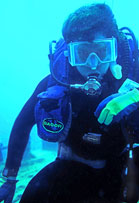









|
Ken Beilman the Author:
Combining Diversions
Scuba diving and underwater photography
 Kenneth
M. Beilman, MD Kenneth
M. Beilman, MD
Internist,
pianist,
photographer,
author,
scuba diver
Scuba diving: ah, the pleasures of the deep, the thrill of gliding
weightless in a watery wonderland, far below the water's surface. All
around is a panoply of colors and a profusion of life, another world to
explore and cherish. This is where life itself began. The surge gently
rocks me to and fro as I slowly descend upon the ancient reef.
The reef is teeming with schools of fish, brightly colored coral, and
scurrying invertebrates. Over there is a purple sea fan, slowly swaying
in the current. A sea snail with its seemingly hand painted markings
adorns the fan and calls for closer inspection. My camera in tow, I snap
a macro photo and hope it captures the beauty of the moment. As I float
over the top of the reef, I spot a queen angelfish. Its hues are
saturated and intense, bright yellow markings stamped on its slate blue
form.
Reacting quickly, I point my camera and shoot. In an instant, the fish
is gone, disappearing in the nooks and crannies of the reef. As I drift
down the reef's side, I spy a purple and yellow fairy basslet navigating
the waters amidst 3 large tube sponges. Trying to not disturb the fish,
I quickly but carefully make my way to the site and click another shot.
The reef harbors an endless bounty of life and photographic
opportunities.
I have been scuba diving since 1980. Since that time, I've logged over
100 dives. I still value the truly unique experience of entering another
world, a world within a world. Drawing on my experience, I hope to
advise would be scuba divers with some helpful pointers in this article.
Diver Training
While I heartily recommend the sport, fledgling divers should not
underestimate the skill needed to safely enjoy scuba diving. I do not
recommend the resort courses for training. These are crash courses that
some resorts offer and consist of just an afternoon of training. Given
the potential for disaster, such abbreviated instruction is ill advised.
There are several diving shops in the Louisville area that offer full
training courses. These involve several days of instruction with both
classroom work and training in a swimming pool. The certification check
out dive is typically in one of the local rock quarries. Upon successful
completion of the course, the novice diver receives a certification card
that designates some measure of competency. Most ethical dive operators
in Florida and the Caribbean require a certification card to dive with
them. Good dive operators will also require a dive log that indicates a
dive within the past year or two. Otherwise, a supervised check out dive
should be necessary.
To Buy or Not to Buy
One of the mistakes I made when I first bought my equipment was buying a
tank. This is a waste because all of the dive operators offer filled
tanks as part of their service. And besides, who wants to pay the
airline freight to ship a tank to Key West and lug it around? The novice
diver should purchase the mask, fins, and snorkel. The diver can rent
the weight belt, buoyancy compensator, regulator, air pressure and depth
gauges, and the tank from the dive operator. Dive computers are nice but
not necessary. This is because the dive operators plan the dives to
avoid problems with decompression and nitrogen narcosis. If diving
becomes a regular activity, it makes sense to purchase all your own
gear.
Underwater Photography
I added underwater photography about 2 years after I began diving. A few
of my photos appear with this article and I describe them in my opening
paragraph. Underwater photography has added an immense amount of
pleasure to my shutterbug interests. It provides a very different
subject matter than most of my photos. Something that most novice
underwater photographers don't know is that a flash is an absolute
requirement to get acceptable pictures. Below 10 feet, without a flash,
everything looks blue to the camera. With a flash, the vibrant reds,
yellows, and oranges become manifest. And the underwater colors of
tropical reefs are amazing! Not surprisingly, the better the camera and
flash, the better the pictures. However, the better underwater cameras
can be fairly complex to operate. This can pose a danger to the novice
diver by having too much equipment to contend with. So I advise some
diving experience without a camera before going overboard with
photography (pun intended).
Growing Discriminating
When I first started diving, springs and sinkholes in Florida were a
real thrill. I didn't mind wrestling with the ¼ inch wet suit for the
72-degree water or not seeing much fish life. Most novice divers will
find these sites exciting. But, after logging many dives in Florida, the
Caribbean, and Hawaii, I became jaded and very particular. If the dive
requires a ¼ inch wet suit or the water is colder than 80 or so degrees,
I 'm not interested. If the dive trip is not to a tropical reef or an
underwater wreck with a least 50 feet of visibility, count me out. If
the dive master doesn't allow divers to buddy-up and explore the reef,
I'll stay onshore. If the water is rough, I'll see you on another day
when it's not. Speaking of rough waters, it is best to avoid the
Caribbean in hurricane season, September through November.
Desirable Dive Sites
The Florida Keys have some great dive spots. John Pennecamp Park, off
Key Largo, is a good example. The reefs typically lie in only 30-40 feet
of water and provide good sites for new divers. Looe Key, near Key West,
is one of my favorite Florida dive destinations. The visibility is
generally at least 50 feet and, being federally protected waters, the
aquatic life is luxuriant. I saw my first sea turtle there, an awesome
sight underwater. Some of my most exciting dives have been on San
Salvador, the Bahamas. On the edge of the continental shelf, San
Salvador offers exhilarating wall dives. The local grouper fish are
friendly and will accept food from anyone who will offer it. Hawaii
offers tremendous and unusual diving experiences. Black coral and
pacific fish highlight the differences from the Caribbean. The Humpback
whales winter in Hawaii and are a stunning underwater sight.
The super bowl of diving in the western hemisphere is probably Grand
Cayman. The visibility is often greater than 100 feet and the underwater
topography is extraordinary. Unlike the Florida coral ridges lying on
the flat ocean floor, Grand Cayman is like the Grand Canyon underwater.
It sits on the edge of the continental shelf with underwater cliffs that
drop 4000 feet straight down. The aquatic life is profuse and diverse.
The dive operators are experienced, helpful, and offer a tremendous
variety of dives - shallow, deep, cave dives, wall dives, night dives,
and shipwrecks. Diving in Grand Cayman is a peak experience. However,
don't expect American standards in their restaurants and accommodations.
So, to experience a truly novel and deep experience, consider scuba
diving. This is one sport where you can really get down. But get the
proper training first and add photography only after you've had some
experience under your weight belt. Scuba diving can provide a lifetime
of exciting adventures.
Reprinted with permission from Louisville Medicine, January
2000, a monthly publication of the Jefferson County Medical Society.
|

